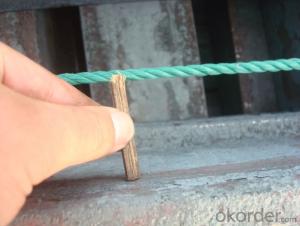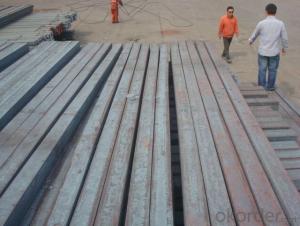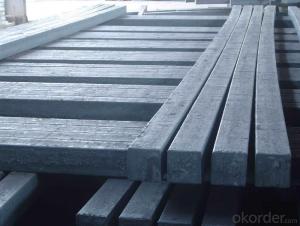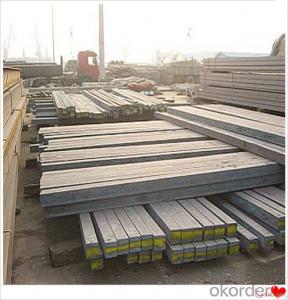Prime Steel Billet Q275, 20MnSi, 5SP,for very good price
- Loading Port:
- Tianjin
- Payment Terms:
- TT OR LC
- Min Order Qty:
- 1000 m.t.
- Supply Capability:
- 20000 m.t./month
OKorder Service Pledge
OKorder Financial Service
You Might Also Like
STEEL BILLET
1.Brief description
Steel billet(ingot) by cogging or breakdown of semi-finished products, is the raw material of all kinds of steel mill. Billet section of square, round, flat, rectangular and abnormity of several kinds of, mainly related to the shape of rolled products.
2.Features
Rectangular billet continuous casting billet and mainly general carbon steel, low carbon low silicon cold-rolled material, high quality carbon structural steel, high strength low alloy steel, special steel, etc.
The billet is mainly divided into two kinds from the shape:
Slab: cross section width and height of the ratio of the larger, mainly used for rolling plate.
Billet: equal cross section width and height, or a huge difference, mainly used for rolling steel, wire rod. ,
Steel billets have distinct characteristics as compared with already furnished steel bars and products. Billets have a specific grain structure, which enables the metal to be processed more intricately. Steel billets are also known for their malleability and ductility, especially when exposed to varying temperatures during shaping and molding.
3.Processing
Steel billets are considered fresh and raw, and they must undergo a series of manufacturing processes before they can be used for various purposes. Billets are made by means of freezing molten liquid, and are later exposed to extremely low temperatures in order to allow the metal to take shape and solidify in chemical structure. The temperature manipulates the metal's physical properties, and tones its strength and durability. The subsequent processes provide the metal's curved mold design so that it can fit the allotted space provided by other machines, which complete the finishing procedures.
4.Pictures
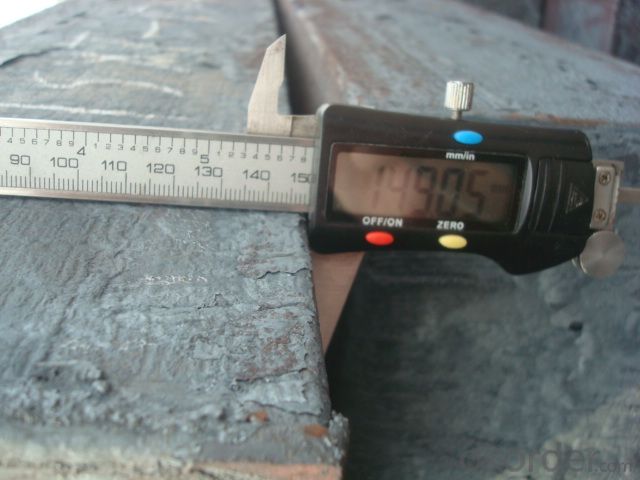

5.Usage
Billets, or ingots (as they sometimes referred to), are not of practical use until they have been formed into more functional shapes and sizes. While they have already been put in the furnace, they still require a series of shaping and molding procedures such as hot and cold working, milling and cutting before they are sold in hardware stores, or used for different applications. The unformed billets, however, can be used in striking currency such as coins and as reserves, similar to gold bars.
6.Detailed specification
Hot rolled billet steel
Size: 50x50mm-180x180mm
Steel Grade: 3SP, 5SP,Q195,Q235,Q255,Q275 Length:3m-12m
MOQ: 1000MT/size
Payment term: TT or LC
Packing: in bulk , bundle
Shipment: by container , bulk vessel
Packaging Details: bundles with steel strips or as customers's requirements
Delivery time: 15-30 days after the deposit
Loading port:Tianjin, or other port China
Origin : China
Inspection:Third party inspection before loading.
- Q:What is the role of steel billets in the manufacturing of material handling equipment?
- Steel billets play a crucial role in the manufacturing of material handling equipment. These billets are essentially semi-finished steel products that are used as the raw material for various manufacturing processes. In the context of material handling equipment, steel billets are typically used in the fabrication of heavy-duty components such as frames, beams, and brackets. These components need to possess high strength, durability, and resistance to wear and tear in order to withstand the demanding conditions that material handling equipment often operates in. The use of steel billets allows manufacturers to create these components with the necessary mechanical properties. The billets are first heated and then shaped through processes like rolling, forging, or extrusion to produce the desired shape and dimensions. This shaping process ensures that the components have the required strength and structural integrity to handle the weight and stress associated with material handling tasks. Furthermore, steel billets offer excellent weldability, which is crucial in the fabrication of material handling equipment. The ability to weld the components together ensures that the equipment can be assembled securely and efficiently. This is especially important for equipment such as cranes, forklifts, and conveyors, where the safe and efficient movement of heavy loads is paramount. Moreover, steel billets provide a cost-effective solution for manufacturing material handling equipment. Steel is widely available, relatively affordable, and can be recycled, making it a sustainable choice. The versatility of steel billets also allows manufacturers to create components of various shapes and sizes, enabling customization to meet specific requirements. Overall, the role of steel billets in the manufacturing of material handling equipment is crucial. They provide the raw material necessary to create strong, durable, and reliable components that can withstand the demanding conditions of material handling tasks. With their excellent mechanical properties and weldability, steel billets contribute to the safe and efficient operation of material handling equipment.
- Q:What are the key properties and characteristics of steel billets?
- Steel billets are semi-finished steel products that are rectangular in shape and typically have a square cross-section. They serve as the starting point for the production of various steel products, including bars, rods, and wire. The key properties and characteristics of steel billets include: 1. Composition: Steel billets are primarily made of iron and carbon, with additional alloying elements added to enhance specific properties. The carbon content typically ranges from 0.2% to 0.5%, depending on the desired strength and hardness. 2. Strength and Hardness: Steel billets offer excellent strength and hardness due to their composition and the heat treatment processes they undergo. This makes them suitable for applications requiring high load-bearing capacity and resistance to wear and tear. 3. Ductility: Despite their strength, steel billets also exhibit good ductility, allowing them to be easily shaped and formed into various products through processes like rolling, extrusion, and forging. This makes them highly versatile and adaptable to different manufacturing methods. 4. Homogeneity: Steel billets have a uniform internal structure, ensuring consistency in their mechanical properties throughout the entire material. This homogeneity is achieved through precise casting and cooling processes, which minimize the presence of defects and impurities. 5. Dimensional Precision: Steel billets are manufactured with specific dimensions and tolerances, ensuring the desired size and shape for downstream processing. This dimensional precision enables efficient and accurate production, minimizing waste and maximizing productivity. 6. Surface Quality: Steel billets have a smooth and clean surface finish, free from any significant imperfections or irregularities. This is crucial for subsequent processing steps, as it ensures proper bonding during welding, machining, or coating operations. 7. Heat Conductivity: Steel billets possess excellent thermal conductivity, allowing them to efficiently transfer heat during various manufacturing processes, such as hot rolling or continuous casting. This property ensures uniform heating and cooling, leading to consistent material properties. 8. Corrosion Resistance: Steel billets are susceptible to corrosion if left unprotected. However, they can be coated or treated with anti-corrosive measures to enhance their resistance to rust and other forms of degradation. Overall, steel billets are characterized by their strength, ductility, dimensional precision, and homogeneity. These properties make them a crucial raw material in the steel industry, enabling the production of high-quality steel products used in a wide range of sectors, including construction, automotive, and infrastructure.
- Q:How are steel billets tested for mechanical properties?
- Steel billets are tested for mechanical properties using various methods to ensure their quality and suitability for specific applications. One common method is the tensile test, which involves pulling a small sample from the billet and subjecting it to a gradually increasing tensile force until it fractures. This test helps determine important mechanical properties such as ultimate tensile strength, yield strength, and elongation. Another method used is the hardness test, which measures the resistance of the billet's surface to indentation. This test provides information about the billet's hardness, which is crucial for assessing its ability to withstand wear and deformation. Additionally, the impact test is performed to evaluate the billet's toughness and ability to absorb energy. This involves striking a standardized sample with a pendulum and measuring the energy absorbed during fracture. The impact test is particularly important for applications where the steel billet is subjected to sudden loads or impacts. To assess the billet's ability to resist deformation, the compression test is employed. In this test, the billet is subjected to a compressive force until it deforms or fractures. The results obtained from this test help determine the billet's compressive strength and deformation characteristics. Furthermore, non-destructive testing methods such as ultrasonic testing and magnetic particle inspection are used to detect any internal defects or irregularities in the billet. These methods involve the use of specialized equipment to examine the billet's internal structure and identify any flaws that may compromise its mechanical properties. Overall, steel billets undergo a comprehensive range of tests to ensure their mechanical properties meet the required standards. These tests help guarantee the quality and reliability of the billets, enabling them to be used in various industries such as construction, automotive, and manufacturing.
- Q:Fish pole carbon cloth tcf. Vcf. Svf. Hcf. On behalf of what?
- According to the T value difference, broadly divided into 4 categoriesHCF: for 24T advanced carbon fiber materialSCF: for 30T advanced carbon fiber materialVCF: for 40T~50T premium carbon fiber materialTCF: for 55T~80T top carbon fiber materialHVF, HCF means high carbon fiber, H High (Senior).HVF:High, Volume, Fiber carbon fiber material 30T-40T.HCF:High, Volume, Carbon, Fiber carbon fiber material 24T."SVF" and "SCF" mean "super high carbon fiber", and "H" means "Super"SVF:Super, High, Volume, Carbon, Fiber carbon fiber material 40T-60T.SCF:Super, Volume, Carbon, Fiber carbon fiber material 30T.
- Q:How are steel billets heated for rolling?
- To prepare steel billets for rolling, they undergo a process known as billet heating or billet reheating. This involves subjecting the billets to high temperatures, making them more malleable and easier to shape during rolling. Various methods can be used to heat steel billets for rolling. One commonly employed technique involves the utilization of a walking beam furnace. Here, the billets are positioned on a conveyor that moves them through a furnace. The furnace is heated to a specific temperature, typically ranging from 1100 to 1250 degrees Celsius, and the billets are exposed to this heat for a predetermined duration. Continuously moving the billets through the furnace ensures uniform heating. Another method for billet heating involves the use of a rotary hearth furnace. In this approach, the billets are placed on a rotating hearth, which is heated by burners located beneath it. As the billets rotate on the hearth, they gradually absorb the heat emitted by the burners, gradually reaching the desired temperature. Induction heating is also a popular option for billet heating. This method employs an induction coil to generate an alternating magnetic field. The billets are placed within the coil, and the magnetic field induces electrical currents within them, resulting in the billets heating up. Induction heating is renowned for its efficiency and precise temperature control. Once the steel billets attain the desired temperature, they are ready for the rolling process. The heated billets are then transferred to a rolling mill, where they undergo further processing and shaping into various forms, such as bars, rods, or sheets. The heating process is crucial, as it enhances the ductility of the steel billets, minimizing the risk of cracking or failure during rolling.
- Q:What are the different types of steel billet defect detection methods?
- The industry commonly utilizes various steel billet defect detection methods to ensure the production of high-quality products. These methods help identify defects or imperfections in the steel billets. Some of the methods include: 1. Visual Inspection: Trained inspectors visually examine the billets for visible defects, such as cracks, surface irregularities, or deformations. While effective for certain defects, internal or hidden defects may go undetected. 2. Ultrasonic Testing: High-frequency sound waves are used to detect defects within the billets. Any disruptions in the waves indicate the presence of defects like cracks or voids. This technique is widely used for detecting internal defects. 3. Magnetic Particle Inspection: The steel billet is magnetized, and iron particles are applied. If there are surface or near-surface defects, the particles are attracted to these areas, making the defects visible. This method is useful for detecting surface cracks and discontinuities. 4. Eddy Current Testing: Electromagnetic induction is utilized to detect surface or near-surface defects. By placing a coil carrying an alternating current near the billet, changes in electrical conductivity or magnetic properties caused by defects are detected. Eddy current testing is particularly effective for detecting surface cracks and corrosion. 5. X-ray Testing: X-ray radiation is passed through the steel billet, and the resulting image is captured on a film or digital detector. Dark spots on the X-ray image indicate internal defects like cracks, voids, or inclusions. This method is highly effective for detecting internal defects. 6. Laser Scanning: A laser scanner is used to create a three-dimensional image of the steel billet's surface. Specialized software is employed to detect and analyze any irregularities or deformations in the surface. Laser scanning is a precise and efficient method for detecting surface defects. These are just a few of the steel billet defect detection methods commonly used in the industry. Each method has its own advantages and limitations, and the choice depends on factors like the type of defect, billet size and shape, and required precision. Employing these methods ensures the production of high-quality steel products.
- Q:What are the main safety precautions in handling steel billets?
- The main safety precautions in handling steel billets include wearing appropriate personal protective equipment (PPE) such as gloves, safety glasses, and steel-toed boots to protect against potential injuries. It is important to use proper lifting techniques and equipment to prevent strains and back injuries. Additionally, ensuring a clean and organized work area helps to reduce the risk of slips, trips, and falls. Regular inspection and maintenance of equipment, as well as proper training and supervision, are crucial to maintaining a safe working environment when handling steel billets.
- Q:How are steel billets classified based on their chemical composition?
- Different grading systems can be used to classify steel billets based on their chemical composition. One commonly used method involves categorizing the billets into three main groups: low carbon steel billets, medium carbon steel billets, and high carbon steel billets. Low carbon steel billets typically contain less than 0.25% carbon and are known for their excellent ductility and weldability. They are often used in applications that require good formability and low strength, such as construction materials and automotive components. Medium carbon steel billets, on the other hand, have a carbon content ranging from 0.25% to 0.60%. These billets offer improved strength and hardness compared to low carbon steel billets and are commonly used in applications that require higher strength, such as machinery parts, shafts, and gears. High carbon steel billets have a carbon content greater than 0.60% and are recognized for their exceptional strength and hardness. They are commonly used in applications that demand high wear resistance, such as cutting tools, springs, and knives. In addition to carbon content, the presence of other chemical elements in the steel billets can also impact their classification. Elements like chromium, nickel, and molybdenum, known as alloying elements, can enhance the properties of the steel, such as corrosion resistance or heat resistance. Steel billets can therefore be further classified based on the specific alloying elements present and their concentrations. Overall, classifying steel billets based on their chemical composition allows for a better understanding and selection of the appropriate material for specific applications. This ensures that the desired properties and performance of the final product are achieved.
- Q:What is the role of steel billets in the construction of bridges?
- Steel billets play a crucial role in the construction of bridges as they serve as the raw material for manufacturing structural steel components. These billets are heated and rolled into various shapes, such as beams, columns, and girders, which form the skeleton of the bridge. The high strength and durability of steel make it an ideal material for bridge construction, enabling bridges to withstand heavy loads, extreme weather conditions, and long-term wear and tear. By providing the foundational material, steel billets contribute to the overall structural integrity and longevity of bridges.
- Q:What are the potential applications of steel billets in the medical aftermarket?
- Steel billets have potential applications in the medical aftermarket for the manufacturing of surgical instruments, orthopedic implants, and medical equipment components. The high strength, durability, and corrosion resistance of steel make it suitable for these applications, ensuring reliable and long-lasting medical devices. Additionally, steel billets can be customized and shaped to meet specific requirements, allowing for the production of complex and intricate medical instruments and implants.
1. Manufacturer Overview |
|
|---|---|
| Location | |
| Year Established | |
| Annual Output Value | |
| Main Markets | |
| Company Certifications | |
2. Manufacturer Certificates |
|
|---|---|
| a) Certification Name | |
| Range | |
| Reference | |
| Validity Period | |
3. Manufacturer Capability |
|
|---|---|
| a)Trade Capacity | |
| Nearest Port | |
| Export Percentage | |
| No.of Employees in Trade Department | |
| Language Spoken: | |
| b)Factory Information | |
| Factory Size: | |
| No. of Production Lines | |
| Contract Manufacturing | |
| Product Price Range | |
Send your message to us
Prime Steel Billet Q275, 20MnSi, 5SP,for very good price
- Loading Port:
- Tianjin
- Payment Terms:
- TT OR LC
- Min Order Qty:
- 1000 m.t.
- Supply Capability:
- 20000 m.t./month
OKorder Service Pledge
OKorder Financial Service
Similar products
New products
Hot products
Hot Searches
Related keywords
